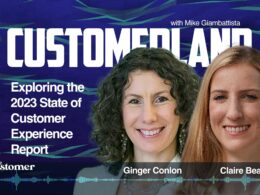Editor’s Note: You’ll notice the little “time-to-read” bit at the top of this article is rather long. We normally don’t publish content of this length on TheCustomer but we felt like we needed to make an exception here. What follows is a very well thought-out contribution by the team at Stratechi that, although it’s a little on the longish side, does a remarkable job of laying out and explaining a workable plan for organizations to formulate their own customer strategies. Pro-tip: Take it in bite-size chunks.
CUSTOMER STRATEGY IS ALL ABOUT YOUR TARGET CUSTOMER(S)
Customer strategy is solving for your target customer(s), which will serve as a focus for the organization, decision making, and other strategies.
The typical output of a customer strategy is a customer persona, which outlines salient descriptors of your target customer, which are relevant and helpful in making strategic decisions.
As with most things strategy, the simpler, the better. While I’ve seen some companies try to navigate up to ten customer segments, typically, those that have defined one, maybe two target customers do a much better job of customizing their value proposition, go-to-market and entire business model to their customers’ needs.
THE BIG PICTURE ON CUSTOMER STRATEGY
- 1. Who is your Target Customer(s)?
The right target customer is key to aligning all of the strategies across a business model. - 2. It’s All About Customer Value
The better you understand your customer, the better you can drive customer value for them. - 3. Customer Personas
The output of a customer strategy are descriptive, insightful and actionable customer personas. - 4. Customer-Centric Companies
Great companies filter decisions and actions through the customer lens.
The below example of a target customer persona (The Jones) for a sporting goods retailer would go a long way in helping shape differentiated strategies to serve “The Jones” better.

A GREAT CUSTOMER STRATEGY ALIGNS AND FOCUSES A BUSINESS MODEL
Truly understanding who your target customers are is a fundamental step to almost any type of strategy. One of the easiest ways to improve a company is to establish and internally publicize the target customer(s) and their persona(s).
If everyone in an organization truly understands who the target customer is then they can:
1. Differentiate the value proposition to the customers’ needs
2. Supercharge & align go-to-market strategies to them
3. Customize every facet of the business to the target customers
4. Ultimately, drive better customer and financial value than competitors

THERE ARE 2 STRATEGIC OPTIONS WITH TARGET CUSTOMERS
The right target customers can unlock the growth potential of a business. Most companies need to focus their target customers, by better defining and evangelizing their existing target customer, or by reducing the number of customer targets they are pursuing. In some instances, a business has the growth option to expand into new target customers, typically after most other growth options have been exhausted (e.g., new products and services, go-to-market, geographies), since expanding into new customer segments can be one of the most expensive and risky strategic growth options.

Below are the typical conditions that lead to either focusing or expanding customer targets.
FOCUS
- Fragmented business
- Org drowning in complexity
- Lack of compelling value proposition
- Don’t understand the customer
EXPAND
- Winning with existing customers
- Superior value proposition
- Clear plan to dominate new target(s)
- High business model synergies
Before we go into a case study on customer strategy, if you want to talk about your customer strategy with an expert, just set up a completely free, no-hassle 30-minute coaching session.
BROOKS SHOES BEGAN THEIR TURNAROUND WITH A CUSTOMER STRATEGY
Brooks, the running shoe company, was founded all the way back in 1914. In the mid-’70s, Brooks became the third largest running brand behind Nike and Adidas. From 1978 to 1980, sales skyrocketed from $14 million to $43 million. With the growth came significant quality issues, which led to financial mismanagement and bankruptcy in 1982.
After being acquired out of bankruptcy for $1.25 million, the 1980s and 1990s were marred by eight consecutive years of losses, driven by an unsuccessful attempt at following Nike’s strategy of expanding into tennis, basketball, baseball, and football with expensive endorsement deals.

THE TARGET CUSTOMER – 35-54 YEAR OLD RUNNERS
In 2001, with $65 million in revenue, but yet again on the verge of bankruptcy, Jim Weber took over as CEO of Brooks. As Jim explains it in an Inc. article, “we were everything to everybody and were sixth, seventh, or eighth at everything.”

The foundation of most growth strategies is a focused target customer. One of the first steps Jim took as CEO was to eliminate customer segments from Brooks, including basketball, baseball and tennis players, and the family looking for inexpensive kids shoes. He focused the entire company on the customer target of 35-54-year-old runners.

Not only was the heritage of Brooks in running, but there was also a nice macro tailwind in running participation, highlighted by the chart below.
ALIGNING BROOKS STRATEGY TO 35-54 YEAR OLD RUNNERS
Once Jim focused in on 35-54-year-old runners, the next step was to align all of Brooks’ business model strategies to this target customer, including the value proposition, go-to-market, and operational strategies. He started by focusing the value proposition on $80+ premium running shoes, the sweet spot for 35-54-year-old runners. This customer focus was a dramatic step for Brooks, as Jim had his team cut half of the product line, which was worth $30 million in sales.

The next step was to focus his go-to-market strategy to better serve 35-54- year-old runners. In parallel to eliminating 50% of his product line, he focused his sales team and distribution on specialty running shoe stores, removing discount retailers and low-price sporting goods from distribution, including his largest customer, Big 5 Sporting Goods. Instead of re-marketing the company, he re-directed the marketing budget to fund the design and development of the next line of Brooks’ premium running shoes. As Jim said in a NY Times article, “The big brands have huge marketing budgets, but the runner looking for the best shoe is the one in charge.”
Once the premium running shoe line was filled out, Jim then focused his marketing efforts on more than 500 grass roots running events across the country, which were highly attended by his target customer of 35-54-year-old runners.

With the value proposition and go-to-market strategies aligned with the needs of 35-54-year-old runners, Jim aligned his organizational and functional strategies to drive the efficiency and effectiveness of developing and delivering the value proposition and go-to-market strategies. He backed up his goal of building the best running shoes for his target customer, by creating a core competency in technical running shoe product development, with a team of product engineers and an advanced running lab.

BROOKS’ CUSTOMER STRATEGY DROVE 18% ANNUAL GROWTH

Brooks focus on serving the needs of 35-54-year-old runners has paid off. Jim and his team grew Brooks’ revenue from $65 million in 2001 to $500 million in 2014. In 2014 Brooks was #1 in specialty running stores with 31% market share. In 2004, Russell Athletics acquired Brooks for $115 million. Subsequently, in 2006 Berkshire Hathaway purchased Russell Athletics, and spun out Brooks as a separate operating company.
THE WORLD OF POTENTIAL TARGET CUSTOMERS

There are so many ways to think about and describe a target customer, which can be distilled into five dimensions (above). In the case of Brooks, they used demographic (mid-to-high income 35-54-year-olds), affinity (runners), and probably a bit of psychographic (likes technology, doesn’t follow the masses) to define their target customer.
What customer dimensions are used to define your target customer?
If you are in a business-to-business (B2B) market, then the dimensions look slightly different. Instead of demographics, there are firmographics, which are attributes of the business, such as industry, size, and location. In B2B, affinity is more about the products and services a company may use. Also, the psychographic dimension deals more with the buying process, decision makers and influencers.

WHAT IS THE RIGHT BREADTH OF TARGET CUSTOMER?
This question trips up a lot of companies, especially small and mid-size companies, which often too broadly define their target customers. They have a tough time tailoring a differentiated value proposition and go-to-market for their customers, because they are trying to be everything to everyone. In the 1990s, Brooks was trying to be a mass shoe brand, when it didn’t have the scale to pull it off. To turnaround the company, they went niche and grew 18% annually for 15 years. Below are some thoughts on niche, broad or mass target customers.

WHAT IS THE RIGHT NUMBER OF TARGET SEGMENTS?
This is another question that trips up many leadership teams. They listen too much to the data scientists who tell them “the cluster analysis created eight distinct segments.” While that may be the theory, the reality is most successful companies focus on one or two target customers. Why? Because, all the employees that are making strategic decisions every day, can only really filter those decisions through one, maybe two customer personas. It is challenging to create a differentiated value proposition and align organizational execution for more than two target customers.
Though, when it comes to marketing execution or some digital value propositions, the gold is in micro-segments and one-to-one personalization, which is possible given the current capabilities in data mining, analytics, and highly targeted marketing channels (e.g., email, online advertising, social).

THERE ARE FOUR STEPS TO CREATING A CUSTOMER STRATEGY

Deciding on the right target customer is both art and science. The art is defining the target customer in a way that gives your value proposition ample room to grow, allows you to differentiate versus competitors, and is easy for employees to understand and use in decisions. The science is in utilizing the best research and analytic techniques out there to drive an insightful and actionable fact base, which is the foundation of your customer strategy. It is not easy, but with the right approach and tools, customer strategy will get you a long way down the road to growth.
You are in great shape if you already have a well-defined target customer that are used to shape and align the company’s strategies. Though, you should still conduct a customer strategy project every few years, as customer and competitor dynamics shift and change.

STEP 1: CONDUCT RESEARCH ON THE MARKET & CUSTOMERS
Step 1 of a customer strategy project is to conduct customer, market and competitive research utilizing both internal and external resources. The goal of the research is to start shaping the architecture of a customer survey, especially the value proposition and go-to-market sections, and scoping out potential areas to deep dive into for further validation and insight.

INTERNAL RESEARCH
What internal data & research do we have or can create? What insights are there? Who are our most valuable customers?
Typical analyses include:
– Internal Research & Analysis
– Pareto, Segmentation & Trend Analysis

EXTERNAL RESEARCH
What market & trend research is there on customers? How is the market segmented? Who are competitors targeting?
Typical analyses and tools used include:
– Market Research
– Problem Solving

HYPOTHESIZE
What is important to customers? What are potential customer segments to focus on? Why? How will we decide?
Typical customer research tools include:
– Brainstorming
– Problem Solving
STEP 2: DESIGN & EXECUTE THE CUSTOMER SURVEY
Regardless of whether you have a defined target customer, conduct a customer strategy survey every few years. We live in a time where dynamics change overnight, competitors pop up from out of nowhere, and generational divides are ever evolving. We’re not going to cover proper survey design and execution (if you need help with that, drop us a note). Instead, let’s focus on what you are trying to accomplish with a survey and the major elements to cover.
Too many companies go for the “what sticks on the wall” approach to surveys, as they throw in the entire kitchen sink, while often omitting some key aspects. One retailer I worked with conducted a survey that turned out to be fairly useless. They didn’t include their primary vendors as a choice for customers to purchase product from, even though 30% of their vendors’ sales were from direct-to-consumer channels (online, factory stores). By omitting vendor channels they didn’t generate any insight on one of the largest market and customer dynamics.
Be very thoughtful and strategic in survey design. You have 15, maybe 20 minutes with survey respondents, before they start giving you junk and dropping out. Prioritize what is important to ask regarding customer descriptors, the value proposition, and go-to-market. When you think you are done with the design, go back and be clever about how you can shrink it more, and drive more insight. A well designed and executed customer survey is the foundation to develop excellent strategies across your entire business model.

DESCRIPTIVE CUSTOMER DIMENSIONS
What are the important demographic, psychographic, behavioral, affinity, and value attributes for target customers?
Typical analyses include:
– Problem Solving
– Brainstorming

VALUE PROPOSITION
What do customers value in the products, services & pricing…now vs. future? How do we compare vs. competition?
Typical analyses include:
– Polling
– Ethnography
– Brainstorming

GO-TO-MARKET
How do customers learn, decide, buy, use? What are effective marketing, sales, and distribution strategies? What are the trends influencing purchasing decisions?
Typical analyses include:
– Research
– Problem Solving
– Brainstorming
STEP 3: DETERMINE THE RIGHT CUSTOMER TARGET(S)
Once you have executed the survey and cleaned up and normalized the survey data, it is time for the systematic analysis and synthesis of the data. You want experienced data science professionals working alongside business experts to drive the continuous hypothesis creation and validation of insights. While there is a much science behind the analysis, the art is in what you are looking for and how best to synthesize the findings.
Once you tease out potential target customer segments from all of the analysis, then you move onto engaging the leadership team in problem solving workshops to deliberate and decide on the right target customer to unlock the growth potential of the business.

GENERATE INSIGHTS
What are the “aha” insights on customer segments, make-up, value, trends, gaps, opportunities? Insights on competitors?
Typical analyses include:
– Cross-tabs & Segmentation Analysis
– Statistical Analysis
– Problem Solving

SYNTHESIZE
What are the top potential target customers? Why? What is the decision criteria and scores for the targets?
Typical analyses include:
– Decision Matrix
– Problem Solving
– Storyboarding

DELIBERATE & DECIDE
Which target customer(s) provide the most value potential for the company? Why? What are the implications?
Typical analyses include:
– Prioritization Matrix
– Facilitated Workshops
STEP 4: EMBRACE THE TARGET CUSTOMER IN STRATEGIES & DECISIONS
Once a team settles on a target customer the hard work begins with getting all the employees minds to embrace the target customer in their thought process, problem solving, strategy development and decision making. Evangelizing is the first step, which is change management 101. Commit the resources for a robust internal marketing campaign. Also, reinforce the target customer in communications and throughout the training, materials and artifacts throughout the employee lifecycle. Put in place the metrics and governance to track success with the target customers. Most importantly, ensure all of the strategies (e.g., business model, value proposition, go-to-market, and functional) align with the needs of the target customers.

EVANGELIZE
What is the plan to market the target customer to employees, and drive change management in decision making?
Typical analyses include:
– Marketing Campaign
– Change Management
– Employee Lifecycle

MEASURE
What target customer success metrics should be measured and reported on? Will there be incentives?
Typical analyses include:
– Business Intelligence
– Governance

ALIGN STRATEGIES
How will other strategies align to and differentiate for the needs and persona of the target customer?
Typical analyses include:
– Strategic Planning
– Brainstorming
– Workshops
FINAL THOUGHTS ON TARGET CUSTOMER STRATEGY
The majority of companies we work with either don’t have a defined target customer or need to define their target customer better. Once they determine the right target customer, solving the rest of the strategies across a business model becomes easier. Customer strategy projects aren’t difficult if you employ the proper methodologies and problem solving. The projects are always full of insight, fun and impact.
If you want to talk about your customer strategy with an expert, just set up a completely free, no-hassle 30-minute coaching session.
This article originally appeared on Stratechi and has been edited slightly for formatting. Photo by David Pisnoy on Unsplash.













